Strain-relief Element For Footwear Articles
Fu; David
U.S. patent application number 16/219782 was filed with the patent office on 2019-11-28 for strain-relief element for footwear articles. The applicant listed for this patent is David Fu. Invention is credited to David Fu.
| Application Number | 20190357633 16/219782 |
| Document ID | / |
| Family ID | 55453509 |
| Filed Date | 2019-11-28 |
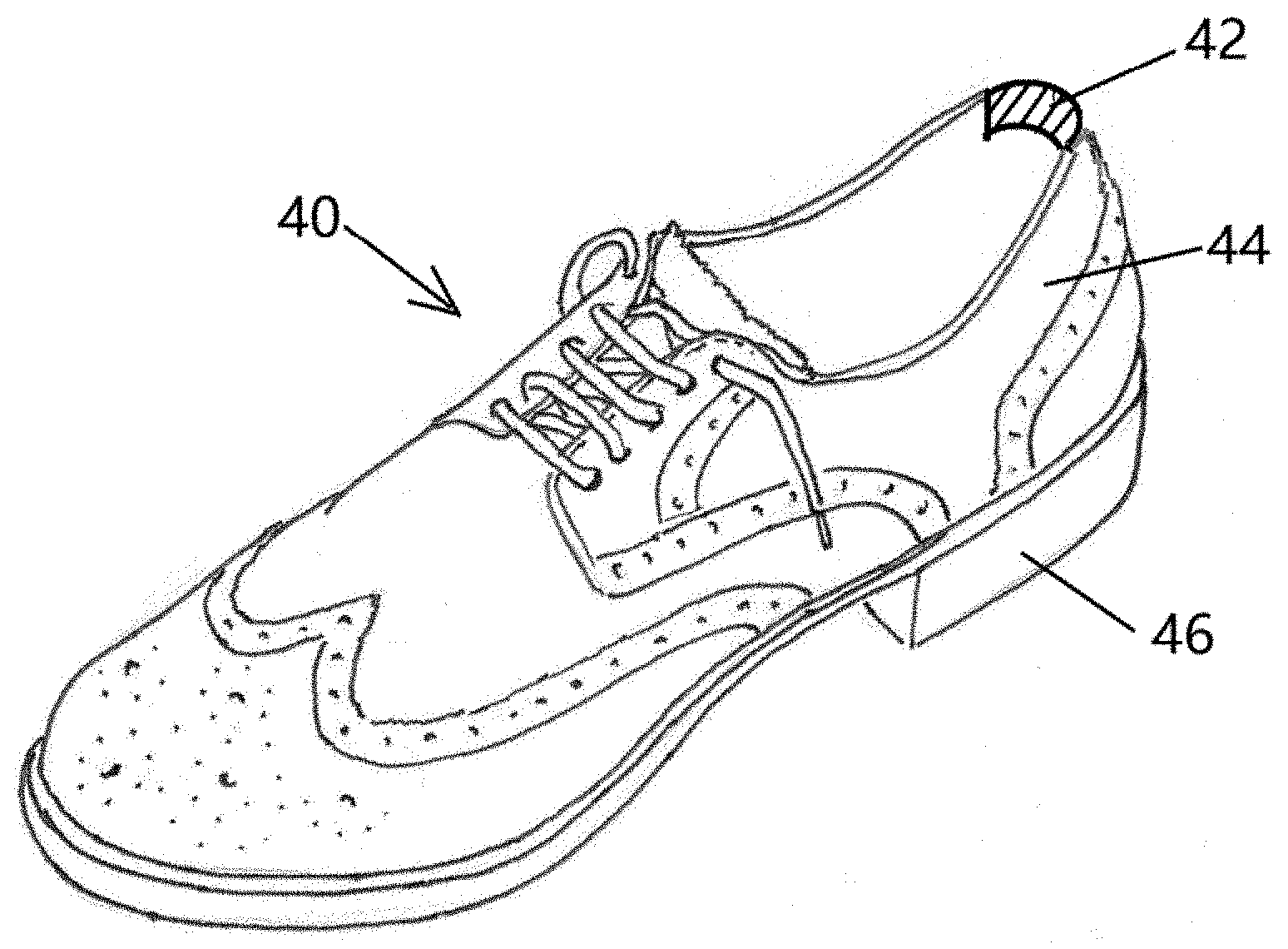

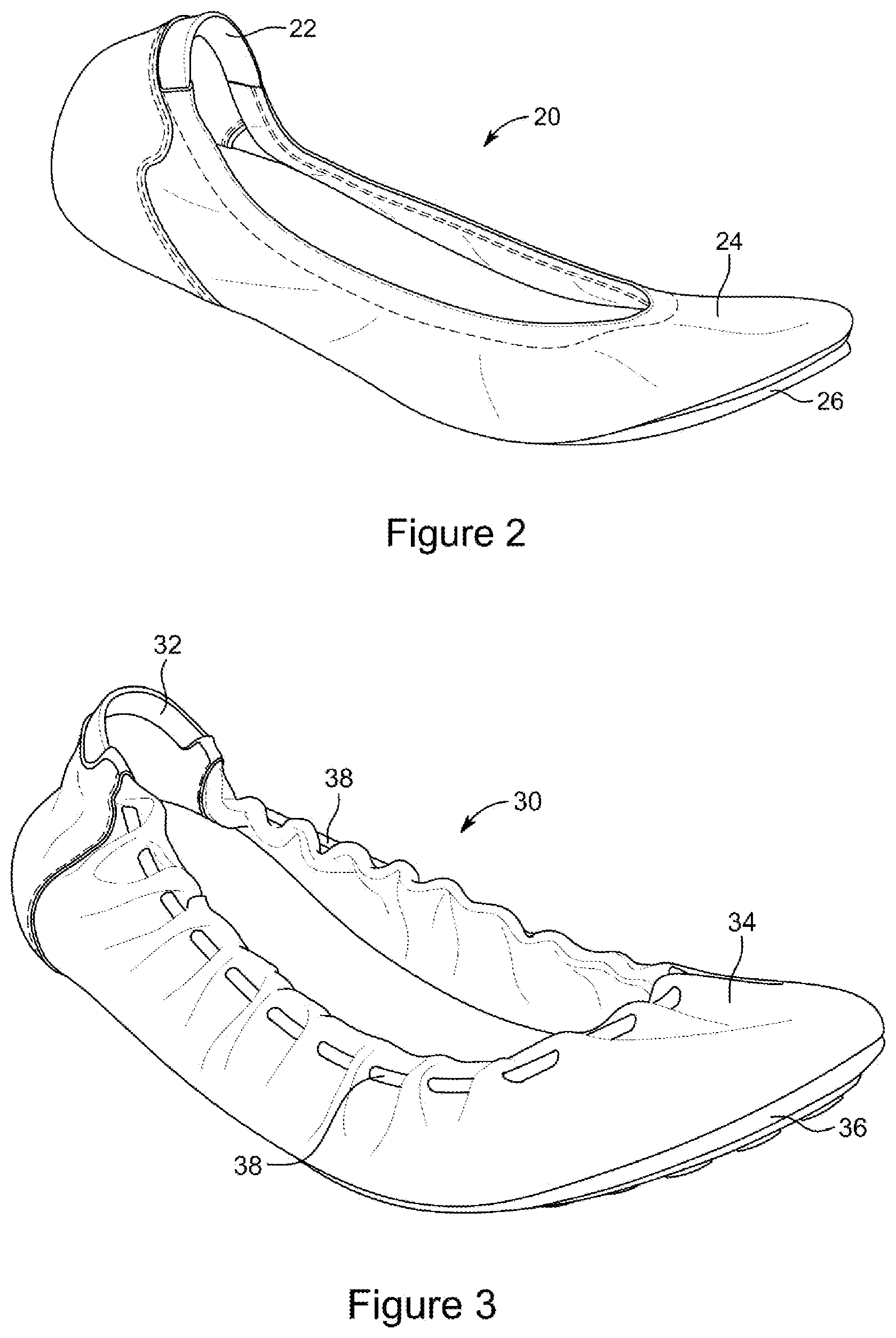

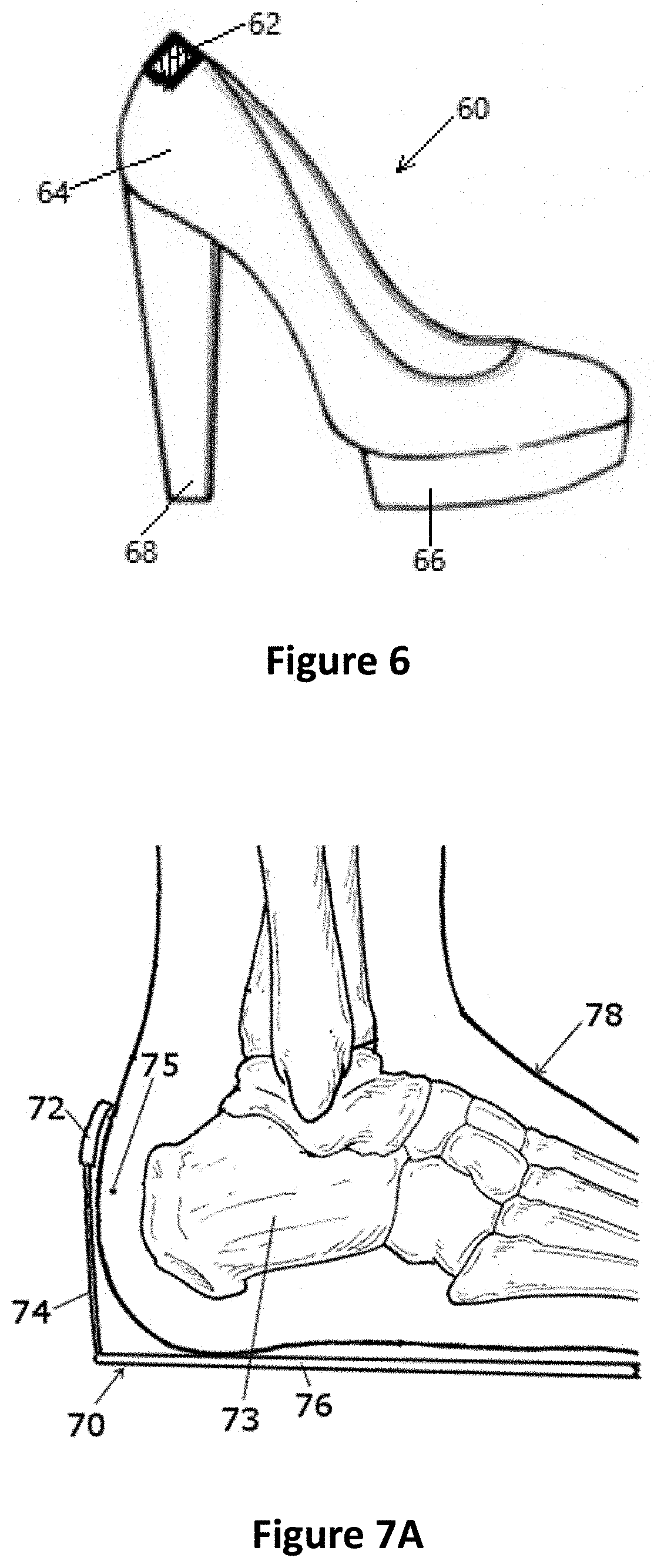
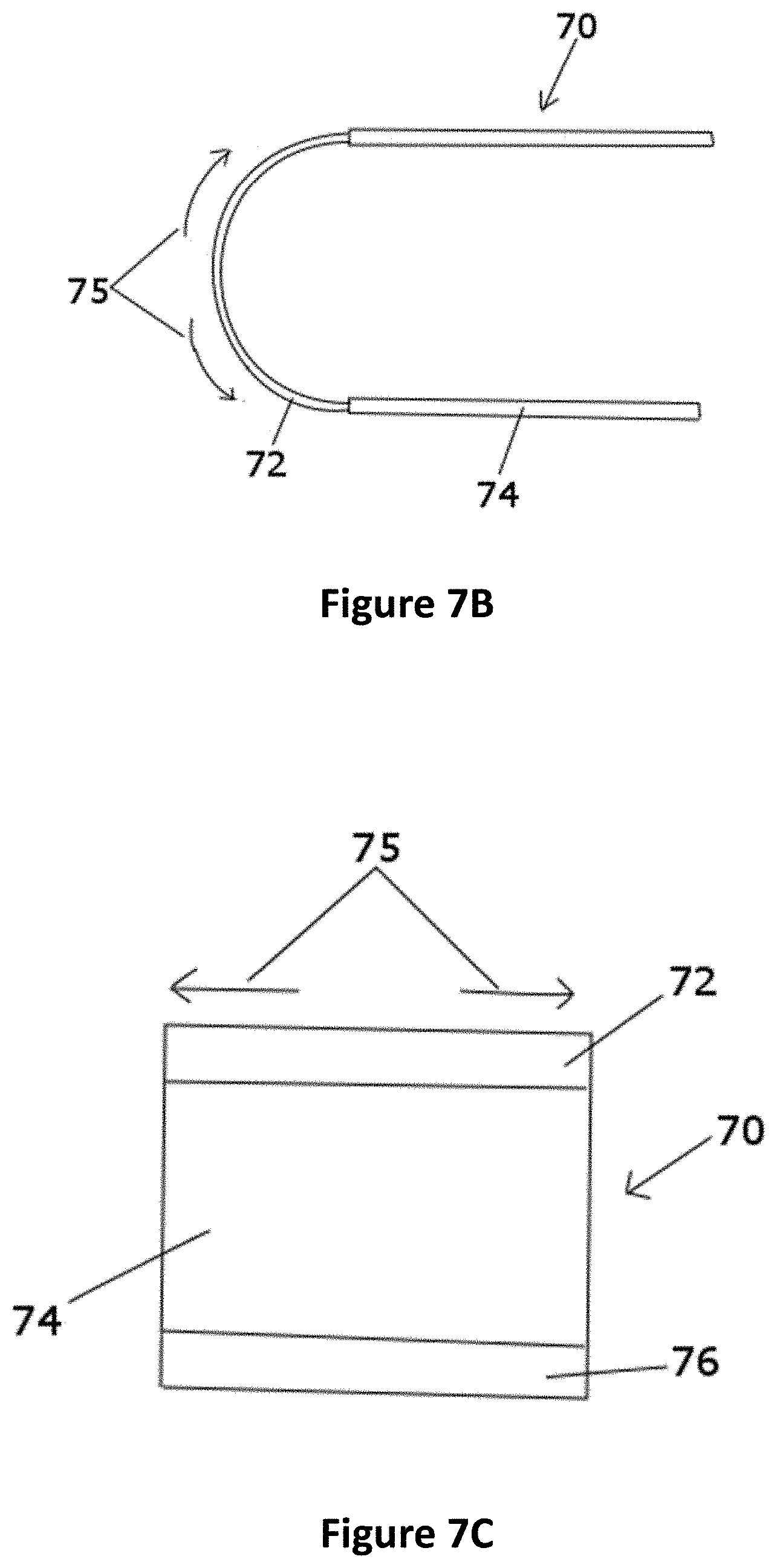
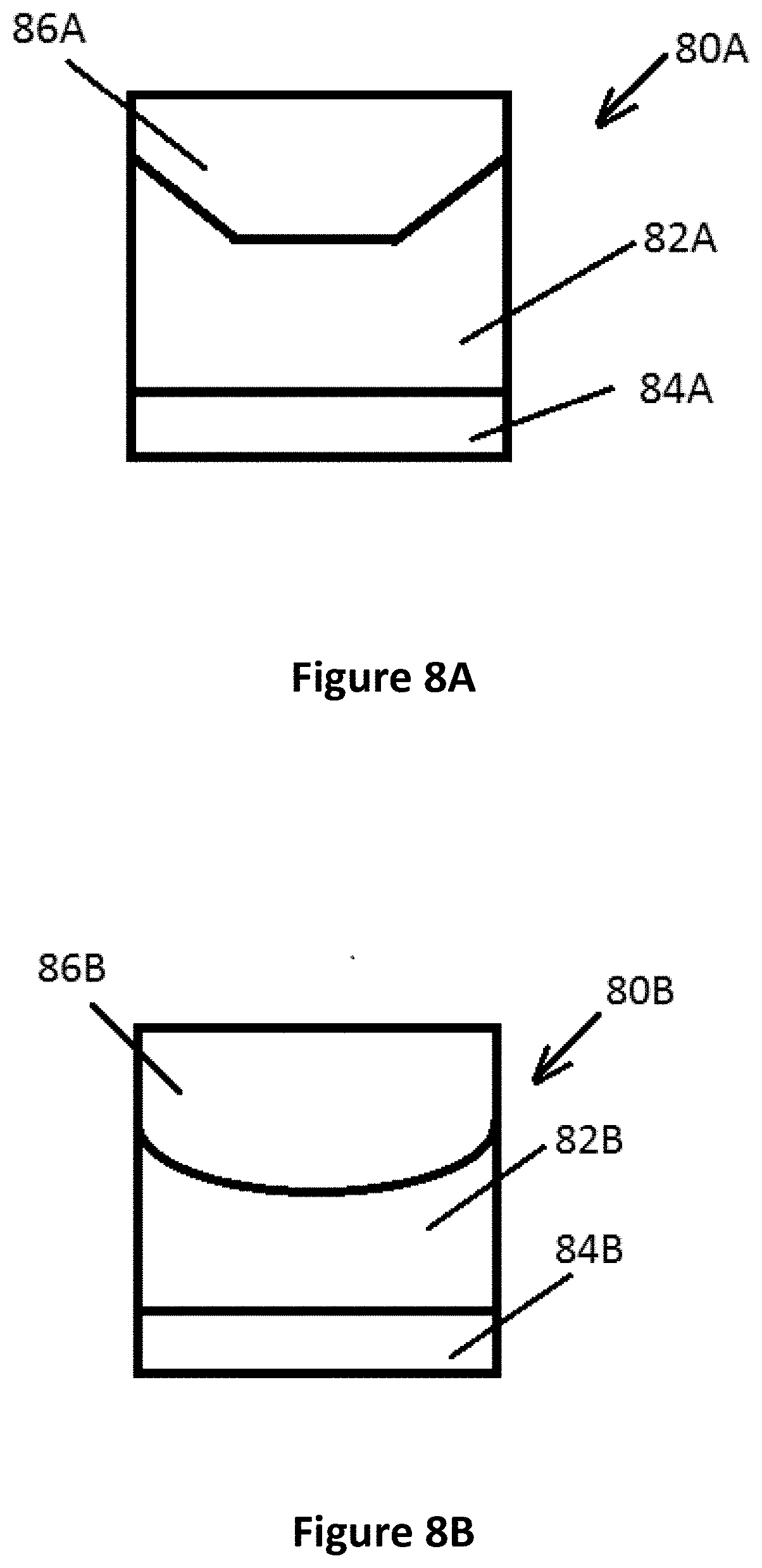

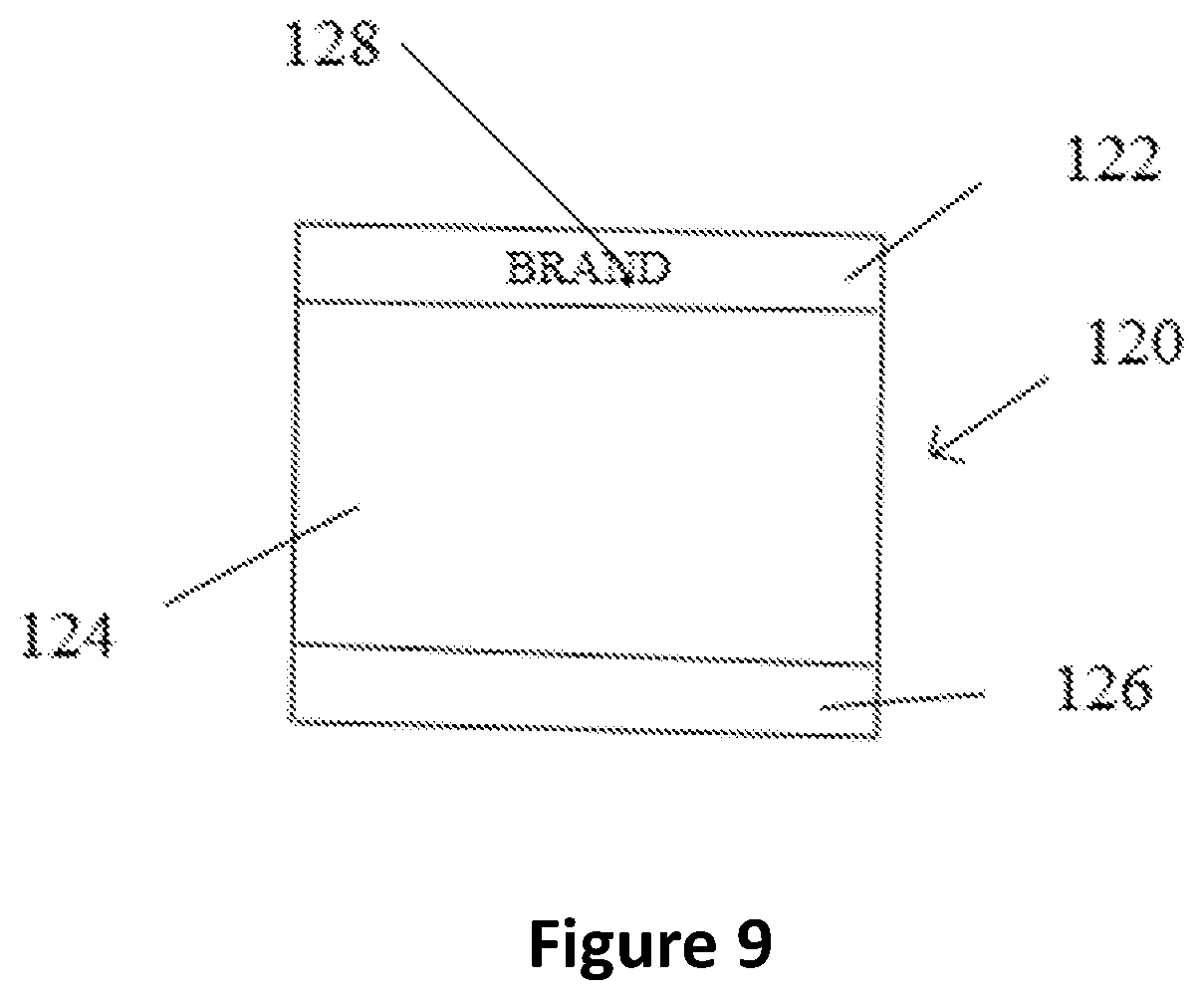
| United States Patent Application | 20190357633 |
| Kind Code | A1 |
| Fu; David | November 28, 2019 |
STRAIN-RELIEF ELEMENT FOR FOOTWEAR ARTICLES
Abstract
A strain relief element for a footwear article is provided. The strain relief element is engageable with a portion of a footwear article for engagement with a portion of the foot of a subject, wherein the strain relief element is formed from an elastically deformable material, the strain relief element is sized and provided with a geometry, such that upon engagement with the engagement portion of a foot of a subject, the strain relief element elastically deforms and the internal surface of the strain relief element which engages with the foot of a user substantially conforms to the engagement portion of the surface of the foot of a subject. Footwear including such a strain relief element are also provided.
| Inventors: | Fu; David; (Kowloon, HK) | ||||||||||
| Applicant: |
|
||||||||||
|---|---|---|---|---|---|---|---|---|---|---|---|
| Family ID: | 55453509 | ||||||||||
| Appl. No.: | 16/219782 | ||||||||||
| Filed: | December 13, 2018 |
Related U.S. Patent Documents
| Application Number | Filing Date | Patent Number | ||
|---|---|---|---|---|
| 15232642 | Aug 9, 2016 | |||
| 16219782 | ||||
| 14484179 | Sep 11, 2014 | |||
| 15232642 | ||||
| Current U.S. Class: | 1/1 |
| Current CPC Class: | A43B 23/28 20130101 |
| International Class: | A43B 23/28 20060101 A43B023/28 |
Claims
1. (canceled)
2. A footwear article for engagement with a foot of a subject, said footwear article comprising: a sole member, an upper attached to said sole member, and a strain relief element engaged with said upper; said strain relief element engaged with said upper and extending about a portion and comprising part of a periphery of an opening of the upper of the footwear article, and said strain relief element formed from an elastically deformable material and having an internal surface for engagement with an engagement portion of the foot of said subject; wherein said strain relief element has a cross sectional area and geometry and a peripheral length such that upon engagement of the internal surface of the strain relief element with said engagement portion of the foot of said subject, the strain relief element provides compressive hoop stress so as to secure said upper and the footwear article to the foot of said subject during ambulation; wherein upon engagement of the internal surface of the strain relief element with said engagement portion of the foot of said subject, the strain relief element elastically deforms and the internal surface of the strain relief element substantially conforms to said engagement portion of the foot of said subject, a load induced during ambulation normal to said engagement portion of the foot of said subject and imparted to said engagement portion of the foot of said subject distributed along the strain relief element so as to reduce point loading to the foot at bony prominences of the foot of the subject; and wherein the strain relief element is formed from said elastically deformable material and said internal surface provides a reduced friction coefficient so to allow movement of the strain relief element during ambulation relative to said engagement portion the foot of said subject, so as to reduce internal shear stresses induced from relative movement between the surface of said engagement portion of the foot of said subject and bones of the foot of said subject.
3. The footwear article according to claim 2, wherein the strain relief element is positioned at an anterior contact portion, a medial contact portion, a lateral contact portion, a posterior contact portion, or combinations thereof of the upper of the footwear article for engagement with a corresponding one of an anterior contact portion, a medial contact portion, a lateral contact portion, a posterior contact portion, or combinations thereof of the engagement portion of the foot of said subject.
4. The footwear article according to claim 2, wherein the strain relief element is positioned at a superior-posterior portion of the footwear article for engagement with a posterior heel portion of the foot of said subject.
5. The footwear article according to claim 4 wherein the strain relief element is formed from the elastically deformable material and finished so as to provide the reduced friction coefficient in order to allow superior and inferior movement of the strain relief element during ambulation relative to a posterior surface of the posterior heel portion of the foot of the subject, so as to reduce internal shear stresses induced from relative movement between the posterior surface of the heel and a calcaneus of the foot of the subject.
6. The footwear article according to claim 2, wherein the elastically deformable material is a material comprising at least one of an elastomeric polymer, a silicon based material, or a rubber based material.
7. The footwear article according to claim 2, wherein the strain relief element is elongate in a lateral direction.
8. The footwear article according to claim 2, wherein the strain relief element further includes a marking, and wherein said marking is a branding or trade mark marking.
9. The footwear article according to claim 3, wherein the strain relief element is provided in a color distinct from the color of the upper to provide a visual indication of the incorporation of the strain relief element within the footwear article.
10. The footwear article according to claim 2, wherein the sole member is provided in the same color as to that of the strain relief element, to provide further visual indication of the incorporation of the strain relief element of the present invention within the footwear article.
Description
FIELD OF THE INVENTION
[0001] The present invention relates to a strain-relief element for footwear articles, more particularly to a strain-relief element for reducing the incident of blisters and abrasions to the posterior aspect of the heel of a person when wearing a footwear article.
BACKGROUND OF THE INVENTION
[0002] Blisters and abrasions occurring on the foot of a person, in particular on the posterior aspect of heel of a person, have long been an affliction to people caused by the wearing of footwear articles.
[0003] Such an affliction is experienced from persons wearing any footwear article which contacts the person's foot, particularly the posterior portion of a person's heel, such footwear articles including sports shoes, dress shoes, boots, enclosed footwear articles, open sandal type footwear articles and the like.
[0004] Blisters and abrasions on the heel often cause severe pain, and may be debilitating, thus causing a person to be immobilised or mobility severely reduced, due to pain experienced during ambulation and contact of a footwear article with the heel region of a person.
[0005] In sports type scenarios, performance of an athlete may be severely compromised from pain experienced during a sports event. In other scenarios such as hiking, either recreationally or for commercial or military related activities, the incidence of blisters and abrasions poses a health and welfare risk, in particular if such ailments occur when a person is in a remote area or location in particular whereby there does not exist the opportunity for evacuation by mechanised transport, or in areas of long distance from transport or assistance, of in areas of rough and awkward terrain.
[0006] Untreated blisters and abrasions may further be exacerbated, and upon lesions of the dermis, further abrasion may occur, with more subcutaneous tissue being exposed, causing immobilisation as well as the potential for infection.
[0007] There are several manners of minimising and treatment of blisters according the prior art:
[0008] (i) Lacing to Minimise Rubbing
[0009] In order to prevent rubbing between the heel of a person and the internal contact surface of a footwear, is to maintain the heel secured firmly within the foot wear article, which is seeks to minimise heel abrasion. Such techniques include "lace-lock" as utilised in some sports type footwear article.
[0010] However, such techniques are only applicable to lace up footwear, and such footwear generally has lace eyelets further towards the rear of the footwear article than typical lace up footwear, thus requiring specific structural constrains and specific footwear type.
[0011] (ii) Taping and Dressings-Protective Layer
[0012] A protective layer may be formed in the anterior heel of a person, by adhering a protective layer to the skin, however blisters may occur and friction may remove or loosen the tape causing stress concentrations and pressure, which may further precipitate blisters. This technique may be used prophylactically, as well as after a blister or abrasion has formed.
[0013] This technique may be used in conjunction with a variety of footwear article types, however the incidence of blister formation may not be obviated, as use of such a technique may also often be unsightly, in particular when used by persons wearing sandals and fashion footwear, in particular when used in conjunction with women's open rear sandals or footwear.
[0014] (iii) Donut-Type Pads
[0015] In order to reduce pressure ant the posterior heel portion of a foot of a person, a "donut" shaped pad may be provided, which id formed from a relatively thick piece of material, typically of a felt type material, having an aperture extending therethrough.
[0016] The pad is taped or affixed to the heel of a person, with the aperture of the pad extending over the region of the heel in the region where a blister is likely to occur, or where a blister has occurred. As such, this technique may be used prophylactically, as well as after a blister or abrasion has formed.
[0017] Whilst providing some protection of the posterior heel portion of a user, such a pad may loosen and exacerbate the formation of a blister or abrasion by stress concentration, as well as be unsightly in use.
[0018] (iv) Integrally Formed Padded Portion
[0019] Another technique of the prior art to minimise or obviate the formation of blisters and abrasion of the posterior portion of a heel of a person, is the incorporation of an integrally formed padded cushioning portion at the superior-posterior portion of a footwear article.
[0020] Such padded portions may be formed with a sponge like material internally, and are generally formed from the same material from which the footwear article is formed.
[0021] Whilst providing some comfort and relief and prevent of blister formation, such padded portions may crack and cause abrasion of the heel, as well as seam portions rubbing or pressing on the heel causing discomfort. Further, such padded portions are generally only able to be incorporated in enclosed-type footwear articles, and can be unsightly and impact unfavourably upon the aesthetic characteristics of the footwear article.
OBJECT OF THE INVENTION
[0022] Accordingly, it is an object of the present invention to provide a strain-relief element for footwear articles that overcomes or at least ameliorates at least some of the deficiencies as associated with those of the prior art.
SUMMARY OF THE INVENTION
[0023] In a first aspect, the present invention provides a strain relief element for a footwear article, said strain relief element being engageable with the portion of a footwear article for engagement with a portion of the foot of a subject, wherein said strain relief element is formed from an elastically deformable material, said strain relief element and is sized and provided with a geometry, such that upon engagement with the engagement portion of a foot of a subject, the strain relief element elastically deforms and the internal surface of the strain relief element which engages with the foot of a user substantially conforms to the engagement portion of the surface of the foot of a subject.
[0024] The load normal to the engagement portion of the foot imparted to the engagement portion of the foot of the subject is distributed along the strain relief element so as to reduce point loading to the foot at bony prominences of the foot of the subject.
[0025] Preferably, the strain relief element is formed a material and finished so as to provide a reduced friction coefficient and to allow movement of the strain relief element during ambulation relative to the foot of the subject, so as to reduce internal shear stresses induced from relative movement between the surface of the foot and bones of the foot of the subject.
[0026] The strain relief element may be located at member at the anterior contact portion, medial contact portion, lateral contact portion, posterior contact portion, or combinations thereof.
[0027] Preferably, the strain relief element is engageable with the superior-posterior portion of a footwear article for engagement with the posterior heel portion of the foot of a subject, and the strain relief element is preferably formed a material and finished so as to provide a reduced friction coefficient and to allow superior and inferior movement of the strain relief element during ambulation relative to the posterior surface of the heel of the subject, so as to reduce internal shear stresses induced from relative movement between the posterior surface of the heel and the calcaneus of the foot of the subject.
[0028] Preferably, the strain relief element is formed from an elastomeric polymer.
[0029] Preferably, the strain relief element is formed from a silicon based material, or alternatively the strain relief element is formed from a rubber based material.
[0030] The strain relief element may further includes a tab portion, and wherein said tab portion provides a gripping portion for assistance in fitting a footwear article to the foot of a subject.
[0031] Preferably, the strain relief element is generally elongate in the lateral direction.
[0032] The strain relief element may include rebates for alteration of the structural properties of the strain relief element.
[0033] The strain relief element may further include a recess or a protruded portion, for the carrying thereon of a marking, wherein said marking may be a branding or trade mark marking.
[0034] In a second aspect, the present invention provides a footwear article comprising a strain relief element according to the first aspect.
[0035] The footwear article may comprise an upper to which the strain relief element is engaged, and a sole member to which the upper is engaged.
[0036] The strain relief element may be provided in a colour distinct from the colour of the upper, providing a visual indication of the incorporation of the strain relief element of the present invention within the footwear article.
[0037] The sole member may be provided in the same or similar colour as to that of the strain relief element, to provide further visual indication of the incorporation of the strain relief element of the present invention within the footwear article.
BRIEF DESCRIPTION OF THE DRAWINGS
[0038] Preferred embodiments of the present invention will be explained in further detail below by way of examples and with reference to the accompanying drawings, in which:
[0039] FIG. 1 shows a schematic representation of the heel region of a subject,
[0040] FIG. 2 shows a drawing of a first embodiment of a footwear article according to the present invention,
[0041] FIG. 3 shows a drawing of a second embodiment of a footwear article according to the present invention,
[0042] FIG. 4 shows a line drawing representation of a further embodiment of a footwear article according to the present invention,
[0043] FIG. 5 shows a line drawing representation of another embodiment of a footwear article according to the present invention,
[0044] FIG. 6 shows a line drawing representation of yet a further embodiment of a footwear article according to the present invention,
[0045] FIG. 7A shows a side view sectional schematic representation of a footwear article with strain relief member according to the present invention,
[0046] FIG. 7B shows a top view schematic representation of a footwear article with strain relief member of FIG. 7A,
[0047] FIG. 7C shows a rear view schematic representation of a footwear article with strain relief member of FIG. 7A and 7B,
[0048] FIG. 8A shows a schematic representation of an embodiment of a strain relief element in accordance with the present invention,
[0049] FIG. 8B shows a schematic representation of another embodiment of a strain relief element in accordance with the present invention,
[0050] FIG. 8C shows a schematic representation of a further embodiment of a strain relief element in accordance with the present invention,
[0051] FIG. 8D shows a schematic representation of an alternate embodiment of a strain relief element in accordance with the present invention,
[0052] FIG. 9 shows a rear schematic view of a footwear article having a strain relief element and including a recess or a protruded portion, for the carrying thereon, such as branding or trade mark marking, in accordance with the present invention.
DETAILED DESCRIPTION OF THE PREFERRED EMBODIMENTS
[0053] In order describe the manner in which the present invention is effected and in contrast to the prior art, an understanding of the biomechanics of the heel region of a foot is required, as well as an appreciation of the physiology behind the formation of blisters, in comparison to mechanisms to which the prior art is directed.
[0054] The formation of blisters has traditionally been thought to be caused by pressure and friction between a footwear article and the foot of a person, such as between a footwear article and heel posterior portion and pressure, and solutions of the prior art directed to addressing or mitigating the traditionally perceived causes of blister formation.
[0055] However, in more recent times, further understanding of biomechanics and tissue mechanics, in particular in the heel region of the foot, has provided underlying causes of blister formation.
[0056] A blister is trauma of the deep layer of skin cells, which is caused by shear between the skin and the underlying bone structures. Shear occurs when there is sufficient friction between two objects or portions of an object, such that when force is applied it moves over the underlying object of less resistance. This is distortion within the skin is called shear. A blister occurs in the case when there no sliding between the skin surface and the sock/shoe interior, rather the sliding/translational motion occurs relative between the skin and the bones.
[0057] Over a period of time, and in particular with lateral foot movements such as experienced in tennis, the shear becomes to an abnormal level and damage is causing, and the damaged area will fill with fluid thus causing a blister.
[0058] By comparison, when there is sliding motion between the sock/shoe and the skin surface, abrasion which damage to only the top layers of skin, and which often results in lesions of the skin and red raw wound. This phenomena is typically observed in poorly fitted or poorly manufactured footwear article which allow movement of a foot within the footwear article.
[0059] Whilst blisters such as those that occur on the posterior of the heel have been traditionally thought be solely caused by the heel moving up and down in the shoe, recent and modern biomechanical and tissue research suggests that blisters are actually formed by the calcaneus (i.e. heel bone) moving excessively which causes adjacent skin to be impinged between the interior of the shoe and the calcaneus. This excessive movement has been suggested to be caused by tight calf muscles, a bony prominence, or biomechanical related issues.
[0060] As such, solutions of the prior art such as taping prevents abrasions, and does not prevent not blisters per se. Thus, taping provides a barrier to the skin to prevent abrasive wear rather than reducing shear within adjacent tissue.
[0061] Blister management may be complex, as the causes are typically multi-factorial, such as foot moisture from sweating, activity level and type, and shoe fit.
[0062] Accordingly, the present invention provides a solution to the cause of both blistering and abrasive wear, which addresses underlying causes of blister formation as well as causes for abrasive wear.
[0063] By way of example and explanation as to how a blister is formed on the foot of a person, reference is made to the heel portion whereby referring to FIG. 1, there is shown a schematic representation of the heel region 10 of a subject, whereby the formation of blisters is demonstrated diagrammatically. When wearing a footwear article which engages with the posterior region of the heel of a subject, frictional forces 6 are present, which are depicted as the tangential and normal components of the frictional force.
[0064] During ambulation, the calcaneus 4 may move from small amount to large amounts as depicted by arrow 2, which causes tissue 3 below the skin surface to be exposed to shear forces as represented by arrows 8, to cause trauma and the formation of a blister, as described above.
[0065] Representations of embodiments of the present invention in the application of blister amelioration at the heel portion of a user are now described with reference to FIGS. 2, 3, 4, 5 and 6, and the manner in which the invention is thereafter described with reference to FIGS. 7A, 7B and 7C.
[0066] A first embodiment of the present invention is depicted in FIG. 2, whereby footwear article 20 is shown which includes a strain relief element 22 located at the superior-posterior portion of the footwear article 20. In the present embodiment, the invention is embodied as a ballet shoe type footwear article, which includes an upper 24 to which the strain relief element 22 is affixed, and which is affixed to a sole member 26. As will be understood, the strain relief element 22 engages with the heel portion of a subject in use, either directly when no socks or stockings are used, or indirectly when socks and stockings are used.
[0067] Referring to FIG. 3, there is shown a second embodiment of the present invention whereby footwear article 30 includes a strain relief element 32 located at the superior-posterior portion of the footwear article 30, again in which the invention is embodied as a ballet shoe type footwear article which includes an upper 34 to which the strain relief element 32 is affixed, and which is affixed to a sole member 36. Again as will be understood, the strain relief element 32 engages with the heel portion of a subject in use, either directly when no socks or stockings are used.
[0068] In the present embodiment, the footwear article 30 further includes a peripheral elastic member 38 which extends around the periphery of the opening in the upper 34 through which a foot is inserted into the footwear article 30, which functions in cooperation with the strain relief element 32 so as to provide a tangential hoop strain which causes the upper to be urged radially inwardly towards the foot of a subject, and provide a fixation mechanism so as to secure the footwear article to the foot of a subject.
[0069] In the present embodiment, the peripheral elastic member is a continuous elastic element which is fixed to the upper 34 adjacent the strain relief element 32, and which extends around the periphery of the upper 34 through a plurality of apertures provided as a series of eyelets, thus providing ease of movement of the peripheral elastic member 38 through the apertures so as to provide a more uniform strain and stress in the peripheral elastic member 38 such that a more even load is imparted to the foot of a user along the aperture in the upper, thus providing increased comfort to the user.
[0070] In the present embodiment, the peripheral elastic member 38 is formed from a silicon elastic material, which may be provided as a single filament structure, or a multi-strand structure.
[0071] As will be appreciated by those skilled in the art, the strain relief element of the present invention is equally as applicable to a variety of footwear articles, such as closed shoes, sports shoes, hiking boots, sandals, fashion shoe articles and the like, examples of which are depicted in reference to FIGS. 4, 5 and 6.
[0072] Referring to FIG. 4, there is shown a further embodiment of the present invention whereby footwear article 40 whereby the footwear article is a lace-up dress shoe. The footwear article includes a strain relief element 42 located at the superior-posterior portion of the upper 44 of the footwear article 40, with the upper being joined to a sole member 46. Again as will be understood, the strain relief element 42 engages with the heel portion of a subject in use, either directly when no socks or stockings are used, or indirectly when socks and stockings are used.
[0073] FIG. 5 depicts another embodiment of the present invention whereby footwear article 50 whereby the footwear article 50 is a sandal including a rear strap portion 54 which is attached to a sole member 56. The footwear article 50 includes a strain relief element 52 located at the superior-posterior portion of the rear strap portion 54 of the footwear article 50. Again as will be understood, the strain relief element 52 engages with the heel portion of a subject in use, either directly when no socks or stockings are used, or indirectly when socks and stockings are used.
[0074] As shown in FIG. 6, there is yet another embodiment of the present invention whereby footwear article 60 is provided as a high-heeled ladies fashion footwear article which includes a closed upper 64 and a heel portion 68 of a sole and a front platform portion 66 of the sole. The footwear article 60 includes a strain relief element 62 located at the superior-posterior portion of the upper 64 of the footwear article 60. Again, as will be understood, the strain relief element 62 engages with the heel portion of a subject in use, either directly when no socks or stockings are used, or indirectly when socks and stockings are used.
[0075] Referring to FIG. 7A, 7B, and 7C, the manner in which the present invention operates is depicted and described schematically. A footwear article 70 is shown for reference which includes a sole member 76 and an upper 74 attached to the sole member, with the foot 78 of a subject engaged with the footwear article 70. A strain relief element 72 is shown which in the present embodiment is located at the superior posterior aspect of the upper 74.
[0076] The strain relief element 72 is formed from an elastic material, such as an elastomeric polymeric material, a silicon based material or a rubber based material.
[0077] The strain relief element 72 and is formed such that the anterior (interior) surface of the strain relief element 72 is relatively smooth, and the strain relief element has a modulus of elasticity and is provided with a cross sectional area and geometry and peripheral length, so as to provide sufficient compressive hoop stress so as to secure the footwear article 70 to the foot 78 of the user during ambulation, whilst providing sufficient movement of the strain relief element relative to the outer surface of the skin of the user such that: [0078] (i) Upon movement of the calcaneus 73 of the foot 78 internal shear stresses in the region 75 are minimised so as to reduce formation of blistering, and [0079] (ii) Wear abrasion from the strain relief element 72 on the outer surface of the skin is minimised due to reduced friction and more uniform load distribution in the radially inward direction from the elastic relief member 72 to the outer skin surface.
[0080] This cumulative effect of the strain relief element, provides additional comfort for a user, whilst reducing the incidence of blistering and abrasion, both which have detrimental effects to a user.
[0081] As will be understood by those skilled in the art, suitable sizing and the geometry of the elastic strain element 72, in combination with the mechanical properties of the material from which the elastic strain element 72 is formed, allows for the provision of sufficient hoop stress to as to sufficiently secure the footwear article to the foot of the user, whilst utilising a material so as to provide a suitably low coefficient of friction, can minimise internal shear and external abrasion of the heel of the foot 78 of a user.
[0082] The strain relief element, when located at the posterior portion of a footwear article, may, in other embodiment, be provided with a gripping portion for assistance in fitting a footwear article to the foot of a subject.
[0083] Referring to FIGS. 8A, 8B, 8C and 8D, there are depicted embodiments of the invention with the strain relief element located at the posterior of footwear articles 80A, 80B, 80C and 80D, having an upper 82A, 82B, 82C and 882D affixed to sole members 84A, 84B, 84C and 84D.
[0084] As will be seen, strain relief elements 86A, 86B, 86C and 86D may be of different shapes and extend partly or fully to the 84A, 84B, 84C and 84D, with exemplary embodiments schematically depicted showing a plurality of strain relief elements 86A, 86B, 86C and 86D which, as will be appreciated by those skilled in the art, may be of any geometry, shape or size, whilst providing the functional attributes of the present invention.
[0085] In accordance with the present invention, the strain relief elements 86A, 86B, 86C and 86D may be provided of a distinctive colour in contrast with the upper 82A, 82B, 82C and 82D or other components of a footwear article, which provides for identification that the strain relief elements 86A, 86B, 86C and 86D are that of the present invention, thus enabling consumes to associate such strain relief elements 86A, 86B, 86C and 86D as being those of the present invention visually. Furthermore, in other embodiments, the sole members 84A, 84B, 84C and 84D may be of the same or similar colour to that of the strain relief elements 86A, 86B, 86C and 86D, providing for further visual identification that such footwear articles 80A, 80B, 80C and 80D embody the strain relief elements 86A, 86B, 86C and 86D of the present invention.
[0086] As will be appreciated by those skilled in the art, the strain relief element may be provided with varying geometry and shape, such as the inclusion of rebates for alteration of the structural properties of the strain relief element.
[0087] Those skilled in the art will also appreciate that in other or alternate embodiments, footwear article may be provided with the strain relief member at the anterior contact portion, medial contact portion, lateral contact portion, posterior contact portion, or combinations thereof.
[0088] No limitation may be made to the structure, shape, geometry, size, location, positioning of the strain relief element of the present invention, by reference to the embodiments, which are exemplary embodiments. Further, no inference or limitation may be taken from the exemplary embodiments in respect of the positioning, location, or number of strain relief elements.
[0089] In other embodiments, such as that as exemplified by the schematic rear representation of a footwear article 120 of FIG. 9, the strain relief element 122 which is engaged with upper 124 which is engaged with a sole member 126, further may include a recess or a protruded portion, for the carrying thereon, such as branding or trade mark marking 128. The branding or trade marking 128 may be incorporated during the manufacturing process when the strain relief element is formed, and the branding of trade mark marking may be on the interior aspect of the strain relief element, the exterior strain relief element, or both the exterior or interior aspect.
* * * * *
D00000

D00001

D00002

D00003

D00004

D00005

D00006

D00007

D00008

XML
uspto.report is an independent third-party trademark research tool that is not affiliated, endorsed, or sponsored by the United States Patent and Trademark Office (USPTO) or any other governmental organization. The information provided by uspto.report is based on publicly available data at the time of writing and is intended for informational purposes only.
While we strive to provide accurate and up-to-date information, we do not guarantee the accuracy, completeness, reliability, or suitability of the information displayed on this site. The use of this site is at your own risk. Any reliance you place on such information is therefore strictly at your own risk.
All official trademark data, including owner information, should be verified by visiting the official USPTO website at www.uspto.gov. This site is not intended to replace professional legal advice and should not be used as a substitute for consulting with a legal professional who is knowledgeable about trademark law.